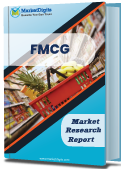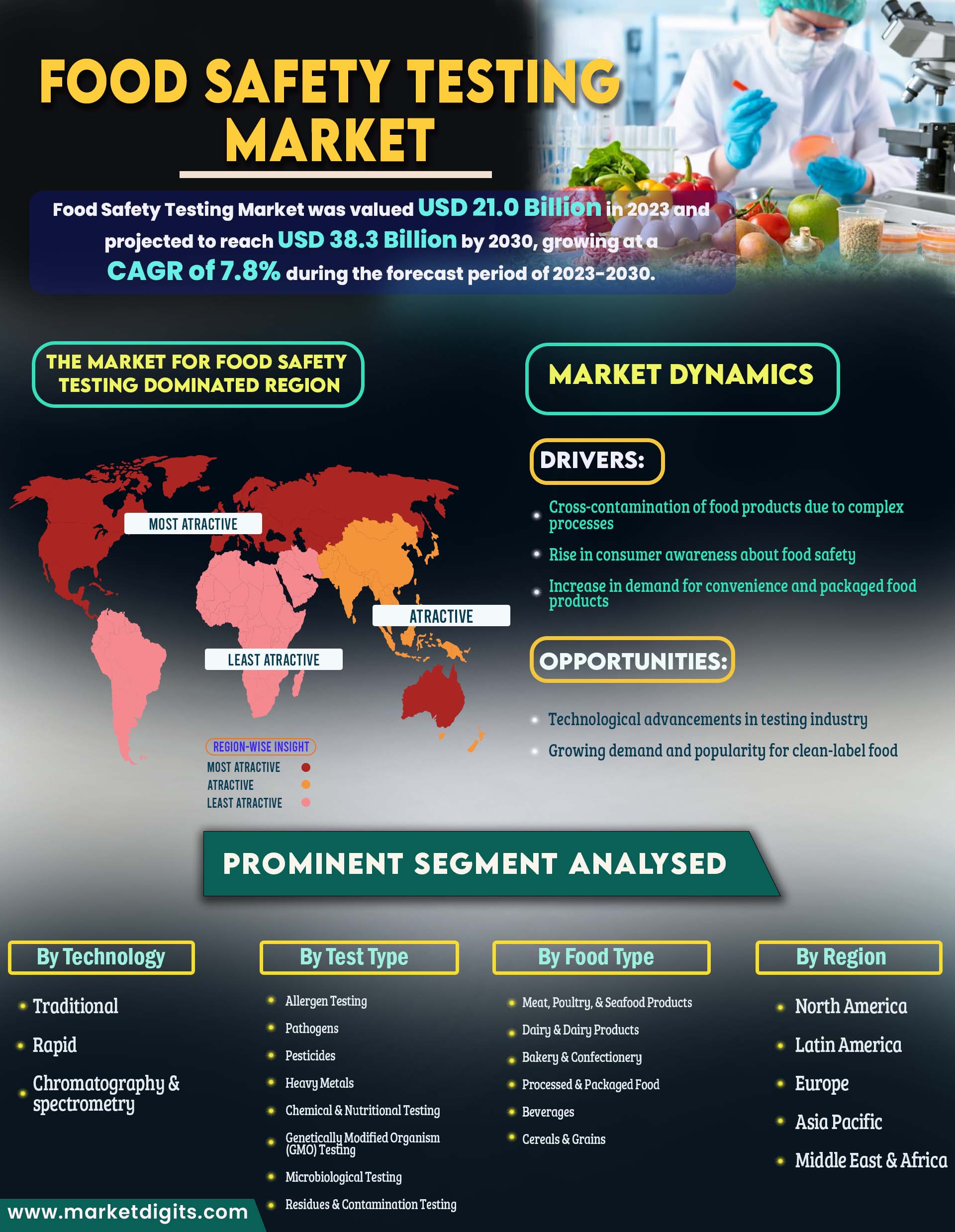
Food Safety Testing Market , By Test Type (Allergen Testing, Pathogens {E.coli, Salmonella, Campylobacter, Listeria and Others}, Pesticides, Heavy Metals, Chemical & Nutritional Testing, Genetically Modified Organism (GMO) Testing, Microbiological Testing, Residues & Contamination Testing and Others), Technology, Food Type, and Region- Partner & Customer Ecosystem (Product Services, Proposition & Key Features) Competitive Index & Regional Footprints by MarketDigits - Forecast 2024-2032
Industry : FMCG | Pages : 179 Pages | Published On : Apr 2024
Market Overview
The food safety testing market plays a crucial role in safeguarding the quality and safety of our food supply. Its capability to identify and eliminate harmful contaminants, pathogens, and toxins in food products is vital for public health protection. Given the increasing public apprehension regarding food contamination and foodborne diseases, coupled with advancements in testing technologies, the food safety testing market is anticipated to experience substantial expansion. The industry is subject to rigorous regulations and encompasses various segments, including food type, technology, and geography. This sector employs both traditional methods such as culture-based and immunoassays, as well as modern techniques like DNA-based and rapid testing. With the continual growth of the food industry and heightened awareness of food safety, the food safety testing market is positioned for sustained success and expansion. The development of cost-effective and innovative testing technologies will be pivotal for its ongoing success, ensuring confidence in the safety of the food we consume.
Food Safety Testing Market Size

| Report | Details |
|---|---|
| Market Size Value | USD 21.65 billion in 2024 |
| Market Size Value | USD 42.91 billion by 2032 |
| CAGR | 7.9% |
| Forecast Period | 2024-2032 |
| Base Year | 2023 |
| Historic Data | 2020 |
| Forecast Units | Value (USD Million/USD Billion) |
| Segments Covered | Test Type, Technology, Food Type, Region and Geography |
| Geographics Covered | North America, Europe, Asia Pacific, and RoW |
Major Players In Digital Twin Market Include: ALS Limited, AsureQuality Limited, Bio-Rad Laboratories, Bureau Veritas S.A., DTS Food Laboratories, EMSL Analytical Inc., Eurofins Scientific SE, Intertek Group Plc., Merieux Nutrisciences, Microbac Laboratories, Inc., NSF International, SGS SA, Symbio, The SOCOTEC Group, Thermo Fischer Scientific Inc., UL LLC and Others.
Rise in the incidence of food-borne illnesses
The global food safety testing market is anticipated to be propelled by the escalating instances of food-borne illnesses worldwide. The primary cause of such illnesses stems from the consumption of spoiled, contaminated, or deteriorated food items containing various microorganisms, including bacteria, fungi, parasites, viruses, and others. Additionally, contaminants like mycotoxins, heavy metals, and chemicals further contribute to the rising prevalence of food-borne illnesses. This surge in cases significantly boosts the demand for food testing kits, equipment, and systems on a global scale. A key factor behind the uptick in food-borne diseases within the food industry is the lack of awareness among the workforce, food handlers, and manufacturers. Their limited understanding of modern technologies, good manufacturing practices (GMP), hazard analysis and critical control point (HACCP) systems, and quality control creates an environment conducive to the increased occurrence of food-borne diseases.
Market Dynamics
Drivers:
- Cross-contamination of food products due to complex processes
- Rise in consumer awareness about food safety
- Increase in demand for convenience and packaged food products
Opportunities:
- Technological advancements in testing industry
- Growing demand and popularity for clean-label food
Incorporating digital solutions to boost precision, streamline efficiency, and ensure compliance is crucial in the field of food safety testing.
The digitization of food safety is on the rise in the food industry, as businesses increasingly embrace digital solutions to achieve more precise recording of food safety data, reduce human error, and facilitate compliance. This trend is expected to persist, driven by the introduction of new software programs and automated applications that enable food businesses to streamline their processes. Currently, software and applications are integrated with machines and sensors, enabling seamless and automated data recording without requiring manual intervention. While these digital solutions are not intended to replace human workers, they contribute to faster and more error-resistant food safety recording. This, in turn, fosters growth in the food safety testing market by providing innovative and effective digital solutions to businesses in the food industry.
The market for Food Safety Testing is dominated by North America.
In 2022, North America dominated the global revenue, the market players established a robust presence through specific product lines and superior food safety testing services. These players leverage advanced manufacturing and marketing techniques to solidify their position in the North American market. Additionally, the rise in disposable income in Canada is anticipated to contribute further to the growth of the food safety testing market in the region. For instance, data from the Mississippi State Department of Health highlights shigellosis, salmonellosis, and campylobacteriosis as the three most prevalent foodborne diseases in Mississippi. This has prompted numerous businesses to offer high-quality food safety testing services, driving an increase in demand.
On the other hand, the Asia-Pacific (APAC) region is expected to exhibit the highest Compound Annual Growth Rate (CAGR) in the Food Safety Testing market. The growth of the food safety market in the Asia Pacific can be attributed to the implementation of rigorous rules and regulations concerning food safety. Governments in the region have enacted various regulations targeting consumers, producers, and regulators alike. The market's expansion in this area is primarily fueled by the increasing demand for processed food in emerging and developing nations such as India, China, Indonesia, and Thailand. Additionally, there is a surge in poisoning outbreaks attributed to the consumption of contaminated meat, along with a rise in cases of food degradation involving contamination, pesticides, and artificial flavoring. In 2007, the APEC Food Safety Cooperation Forum (FSCF), led by China and Australia, was established to enhance the technical competence of food safety management and detection practices across the entire food supply chain.
The Polymerase chain reaction (PCR) Segment is Anticipated to Hold the Largest Market Share During the Forecast Period
The food safety testing market is categorized by technology into Traditional, Rapid (including Convenience-based, Polymerase Chain Reaction (PCR), and Immunoassay), and Chromatography & Spectrometry. In 2021, the PCR-based assay segment held the largest market share, a trend expected to continue during the forecast period. Real-time polymerase chain reaction, being a rapid and cost-effective quantitative technique, contributes to this dominance by swiftly detecting both intentional and unintentional food adulterations caused by biological contaminants. It achieves this by quantifying the amount of specific DNA segments present in samples. Furthermore, the agricultural biotechnology industry extensively employs PCR technology throughout product development, particularly to identify genetically modified material in samples. As the food landscape rapidly evolves in terms of diversity, quantity, and mobility, robust food analysis becomes even more crucial to ensure quality and safety. Polymerase chain reaction testing, being adept at identifying a wide range of products, including meat and meat products, plants used as food ingredients, genetically modified organisms, food-borne viruses or bacteria, and allergens, is gaining popularity. This popularity is poised to drive the growth of the food safety testing market, emphasizing the significance of advanced technology in ensuring the safety and quality of our food.
Major Segmentations Are Distributed as follows:
- By Test Type
- Allergen Testing
- Pathogens
- E.coli
- Salmonella
- Campylobacter
- Listeria
- Others
- Pesticides
- Heavy Metals
- Chemical & Nutritional Testing
- Genetically Modified Organism (GMO) Testing
- Microbiological Testing
- Residues & Contamination Testing
- Others
- By Technology
- Traditional
- Rapid
- Convenience-based
- Polymerase chain reaction (PCR)
- Immunoassay
- Chromatography & spectrometry
- By Food Type
- Meat, Poultry, & Seafood Products
- Dairy & Dairy Products
- Bakery & Confectionery
- Processed & Packaged Food
- Beverages
- Cereals & Grains
- Others
- By Region
- North America
- US
- Canada
- Latin America
- Brazil
- Mexico
- Argentina
- Colombia
- Chile
- Peru
- Rest of Latin America
- Europe
- Germany
- France
- Italy
- Spain
- U.K.
- BENELUX
- CIS & Russia
- Nordics
- Austria
- Poland
- Rest of Europe
- Asia Pacific
- China
- Japan
- South Korea
- India
- Thailand
- Indonesia
- Malaysia
- Vietnam
- Australia & New Zealand
- Rest of Asia Pacific
- Middle East & Africa
- Saudi Arabia
- UAE
- South Africa
- Nigeria
- Egypt
- Israel
- Turkey
- Rest of MEA
- North America
Recent Developments
- In May 2022, Bureau Veritas, a company offering laboratory testing, inspection, and certification services, has revealed the inauguration of its third microbiology laboratory in the United States, situated in Reno, Nevada. This facility is strategically designed to perform swift pathogen testing and microbiology indicator analyses, particularly catering to the agri-food sector.
- In April 2022, Mérieux NutriSciences, a prominent company in food safety, quality, and sustainability, has successfully acquired Hortec Pty Ltd (Hortec) in South Africa and Laboratorios Bromatológicos Araba SA (Aralab) in Spain. Through these recent acquisitions, Mérieux NutriSciences is advancing its strategic goals and enhancing its capabilities by entering the South African pesticide market and solidifying its geographical footprint in Spain.
Answers to Following Key Questions:
- What will be the Food Safety Testing Market’s Trends & growth rate? What analysis has been done of the prices, sales, and volume of the top producers of Food Safety Testing Market?
- What are the main forces behind worldwide Food Safety Testing Market? Which companies dominate Food Safety Testing Market?
- Which companies dominate Food Safety Testing Market? Which business possibilities, dangers, and tactics did they embrace in the market?
- What are the global Insight Engines industry's suppliers' opportunities and dangers in Food Safety Testing Market?
- What is the Insight Engines industry's regional sales, income, and pricing analysis? In the Food Safety Testing Market, who are the distributors, traders, and resellers?
- What are the main geographic areas for various trades that are anticipated to have astounding expansion over the Food Safety Testing Market?
- What are the main geographical areas for various industries that are anticipated to observe astounding expansion for Food Safety Testing Market?
- What are the dominant revenue-generating regions for Food Safety Testing Market, as well as regional growth trends?
- By the end of the forecast period, what will the market size and growth rate be?
- What are the main Food Safety Testing Market trends that are influencing the market's expansion?
- Which key product categories dominate Food Safety Testing Market? What is Food Safety Testing Market’s main applications?
- In the coming years, which Food Safety Testing Market technology will dominate the market?
TOC
Table and Figures
Methodology:
At MarketDigits, we take immense pride in our 360° Research Methodology, which serves as the cornerstone of our research process. It represents a rigorous and comprehensive approach that goes beyond traditional methods to provide a holistic understanding of industry dynamics.
This methodology is built upon the integration of all seven research methodologies developed by MarketDigits, a renowned global research and consulting firm. By leveraging the collective strength of these methodologies, we are able to deliver a 360° view of the challenges, trends, and issues impacting your industry.
The first step of our 360° Research Methodology™ involves conducting extensive primary research, which involves gathering first-hand information through interviews, surveys, and interactions with industry experts, key stakeholders, and market participants. This approach enables us to gather valuable insights and perspectives directly from the source.
Secondary research is another crucial component of our methodology. It involves a deep dive into various data sources, including industry reports, market databases, scholarly articles, and regulatory documents. This helps us gather a wide range of information, validate findings, and provide a comprehensive understanding of the industry landscape.
Furthermore, our methodology incorporates technology-based research techniques, such as data mining, text analytics, and predictive modelling, to uncover hidden patterns, correlations, and trends within the data. This data-driven approach enhances the accuracy and reliability of our analysis, enabling us to make informed and actionable recommendations.
In addition, our analysts bring their industry expertise and domain knowledge to bear on the research process. Their deep understanding of market dynamics, emerging trends, and future prospects allows for insightful interpretation of the data and identification of strategic opportunities.
To ensure the highest level of quality and reliability, our research process undergoes rigorous validation and verification. This includes cross-referencing and triangulation of data from multiple sources, as well as peer reviews and expert consultations.
The result of our 360° Research Methodology is a comprehensive and robust research report that empowers you to make well-informed business decisions. It provides a panoramic view of the industry landscape, helping you navigate challenges, seize opportunities, and stay ahead of the competition.
In summary, our 360° Research Methodology is designed to provide you with a deep understanding of your industry by integrating various research techniques, industry expertise, and data-driven analysis. It ensures that every business decision you make is based on a well-triangulated and comprehensive research experience.

• Product Planning Strategy
• New Product Stratergy
• Expanded Research Scope
• Comprehensive Research
• Strategic Consulting
• Provocative and pragmatic
• Accelerate Revenue & Growth
• Evaluate the competitive landscape
• Optimize your partner network
• Analyzing industries
• Mapping trends
• Strategizing growth
• Implementing plans
Covered Key Topics
Growth Opportunities
Market Growth Drivers
Leading Market Players
Company Market Share
Market Size and Growth Rate
Market Trend and Technological
Research Assistance
We will be happy to help you find what you need. Please call us or write to us:
+1 510-730-3200 (USA Number)
Email: sales@marketdigits.com







